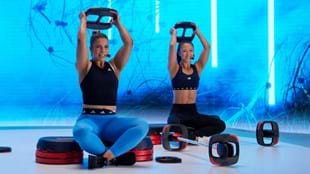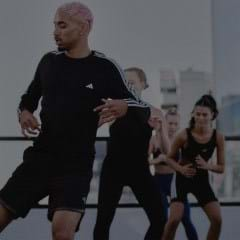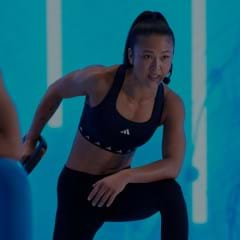- Improve your lifting technique
Track 4, Back, has a new feel, with a dynamic High Pull/ Hang Clean Combination. The tempo is fast, demanding good technique to ensure we ‘get under the bar’. When performed well, this combination will help us to lift efficiently; improve speed and power; and enhance our overall athleticism.
To increase power in this movement, focus on exploding out of the bottom of the lift. This enables us to accelerate the bar upwards and avoid ‘muscling the bar’. It’s also where we derive maximum benefits from the hip drive.
As Ben Main says on the Masterclass: “Hips drive forward and up, big pull out of the bottom, pull your body under the barbell”. Additionally, coach your members to lead the movement with their elbows and keep the bar close to the body, avoiding that reverse curl movement we occasionally see in class that can place extra strain on the wrists and elbows.
The combination is paired with a single arm plate row – unilateral training to ensure we’re strong on both sides of the body. Watch out for twisting through the hips (remind your members to brace their core to stay square) and elbows flaring out to the side. Remember to note the bar options on the Masterclass, as this will keep the intensity high for those who can’t lift enough load with the plate option.
Teaching tip: Encourage your members to go lighter on their weights the first few times they try the High Pull/ Hang Clean Combination – as demonstrated on the Masterclass – so they can master the quick tempo.
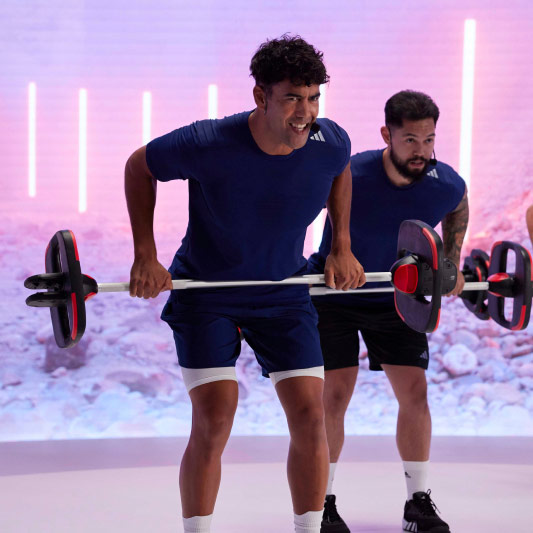
- Increase your bicep weight
You’ve experienced the Preacher Curl in recent releases; BODYPUMP 125 takes this movement to the next level with the introduction of the single arm variation!
Single Arm Bicep Curls are popular in the weights room because they allow us to devote more input to one side. Ben Main, who choreographed this track, says: “Working one arm at a time allows you to invest more energy into each arm for a more focused contraction, rather than splitting energy into both arms.” As a result, people can often lift more weight in a single curl than a bilateral one. These Single Arm Curls may therefore enable people to push through a training plateau and increase their biceps weight.
Teaching tip: Remind your participants that the elbow should track directly under the shoulder, and to take the bar away from the body in the Preacher Curl. Remember: if using the single plates doesn’t suit your members/your club’s equipment, they can stay with the barbell option as demonstrated on the Masterclass.
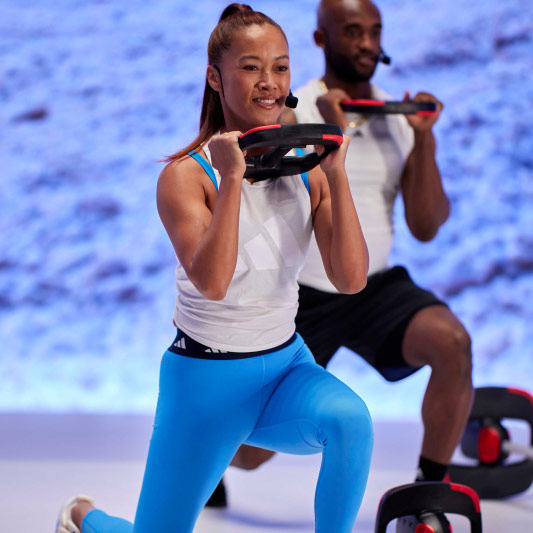
- Improve your leg strength and core stability
Track 7, Lunges, mixes things up with Forward-Stepping Lunges on the bench!
We typically see Backward-Stepping Lunges in most Les Mills programming. Bryce Hastings, Les Mills Head of Research, says: “This is because Forward-stepping Lunges on the floor require lots of deceleration in the front leg as it makes contact with the ground, thereby increasing the compressive and impact forces on the front knee. This will often result in the front knee moving forwards past the front ankle – increasing the amount of flexion – further increasing the pressure on the joint. Backward-Stepping Lunges make it easier to eliminate these issues and have the same amount of muscle activation as Forward-Stepping Lunges, so are considered safer and just as effective, especially in a group setting.
“BODYPUMP 125 employs a Forward-Stepping Lunge onto a step. As we’re actively stepping up, there’s less deceleration than stepping forward to the floor – so we don’t see the issues described above. Transitioning from a Forward to Backward-Stepping Lunge allows us to focus on the stationary leg. Keeping the knee bent and aligned with the middle toes allows us to focus on precision and control – creating time under tension and ultimately resulting in stronger lower limb stabilizers.”
Teaching tip: The space required to perform both the Forward and Backward-Stepping Lunges will be twice as much as a normal Lunge. For those without benches, we recommend substituting the Forward-Stepping Lunges with Backward-Stepping Lunges.



